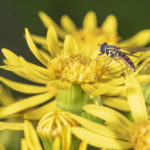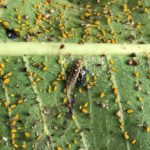Recently we have received reports of swarms of hover flies (aka syrphid flies) around Indiana and wanted to take the opportunity to tell you a bit about this curious insect. Adult hover flies can sometimes be mistaken for bees or wasps, because they look a lot like them! Some people refer to hover flies as “sweat flies” or “sweat bees,” but these insects are actually quite different from bees.
Hover flies belong to the Order Diptera, or the true flies.
- Hoverflies commonly feed on pollen as adults (Photo by J. Obermeyer).
- Hover fly larvae have distinct stripes that run along the sides of their bodies. This larva is a predator that feeds on milkweed aphids (Photo by C. Sadof).
The swarms of flies that we have been hearing about belong to the genus Toxomerus, which feed on pollen rather than other soft-bodied insects, like aphids. Hover flies are typically lighter in color, have a characteristic abdomen-bobbing behavior, and cannot sting at all – in fact, they are harmless. Sweat bees, on the other hand, are typically dark or metallic in color, smaller than common bees and do have stingers. Both hover flies and sweat bees can be a minor nuisance. They are attracted to us by moisture and salts they get by lapping up our sweat. Sweat bees will sting if accidently squished against our skin while they are feeding.
In corn fields and other flowering crops, you will likely find the larval form of this insect, a small, rather plain-looking maggot, feeding in leaf axils and other areas where pollen collects.

Corn pollen grains adult hover fly and yellow larvae with brown stripes along the length of its body. (Photo by J. Obermeyer).
Be advised that the larvae are not pests, as they do not damage the crop. Rather, they are taking advantage of an abundance of pollen. This holds true for other flowering crops as well. As corn continues to mature at a more staggered rate than usual this year (a result of the wet spring and delayed/sporadic planting), you may continue to see these insects. Just remember they are not pests and cannot sting you, they just might be a bit bothersome hovering around you in large numbers!.
Use the Purdue Doctor apps to help you identify these and other insects found on flowers.

